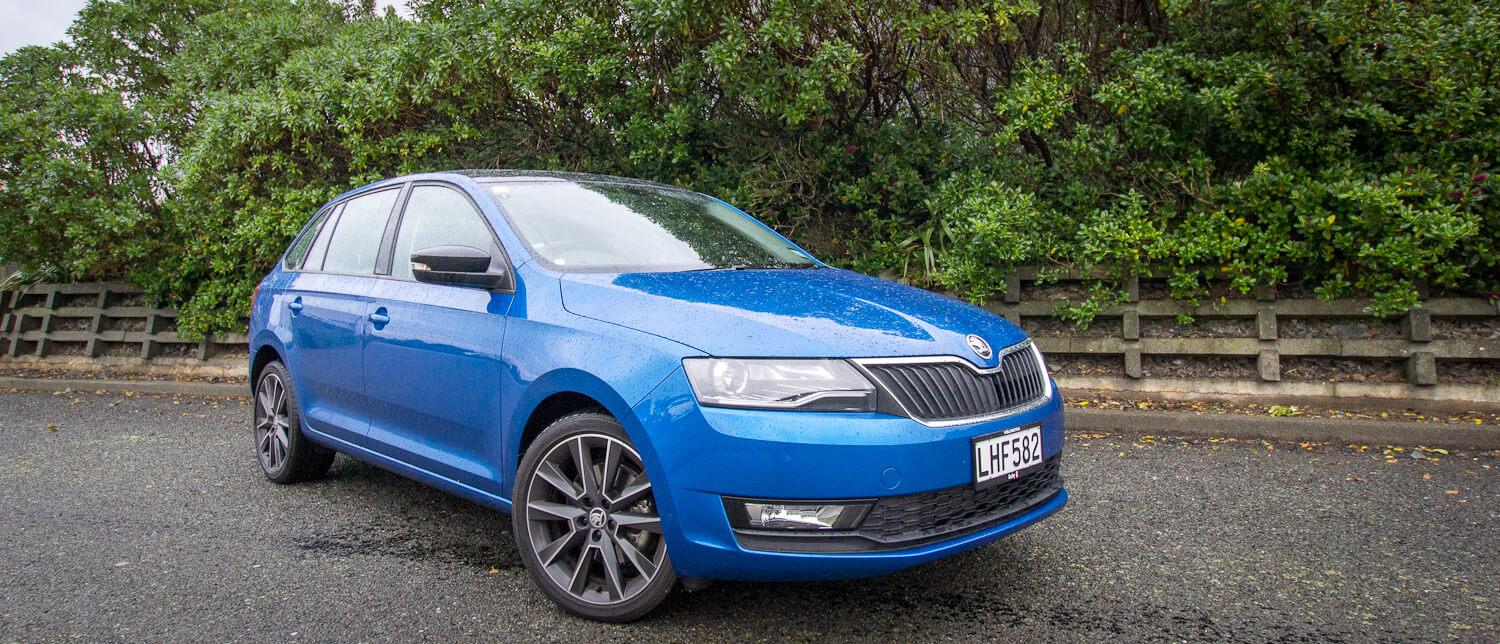Skoda is becoming a more and more popular brand in New Zealand with the Kodiaq which we reviewed last year taking our 2017 award for the Best Value Car of the Year. I was interested to see what the new Skoda Rapid Sport Spaceback was going to offer.
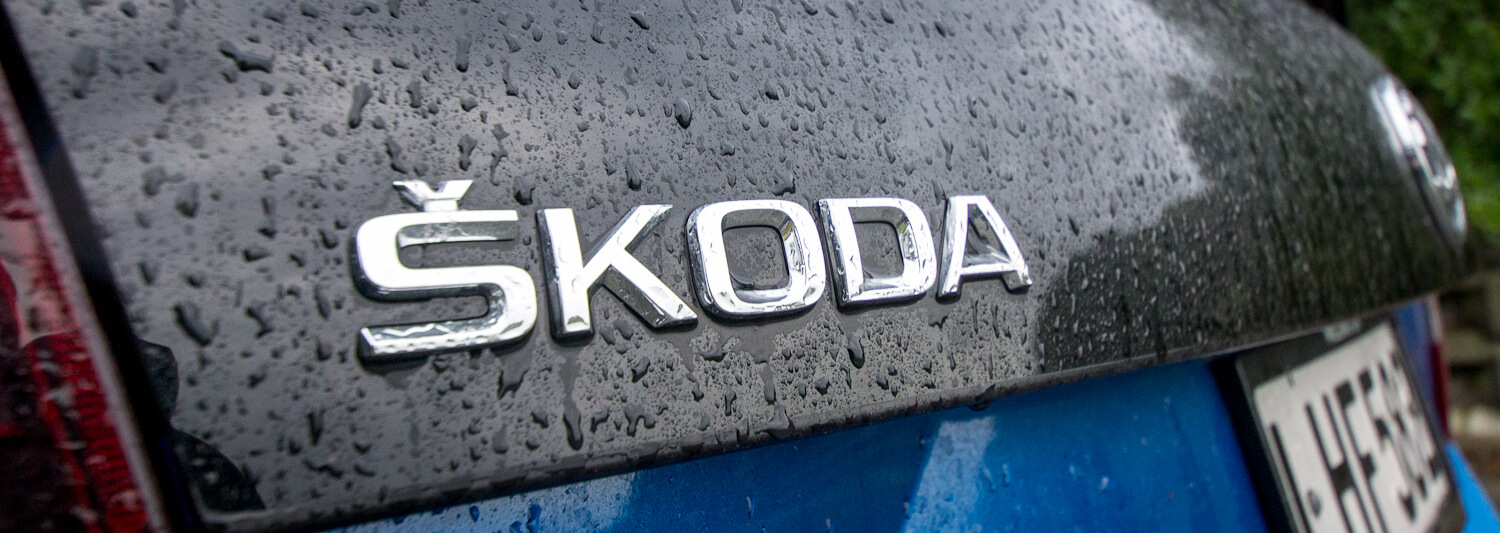
The Range
The Skoda Rapid has a somewhat small range compared to some other brands out there. In New Zealand, we have the Ambition and the Sport.
The Ambition is the base model of the Rapid starting at $27,590. It comes with a 1-litre, 4 cylinders, turbocharged petrol engine with 70kW of power and 160Nm of torque. The Sport starts at $29,900 and comes with a 1.4-litre turbocharged petrol engine that has 92kW of power and 200Nm of torque – this is the same engine that came in the old Mk7 Golf. Both models come with a 7-speed DSG and are front-wheel drive.
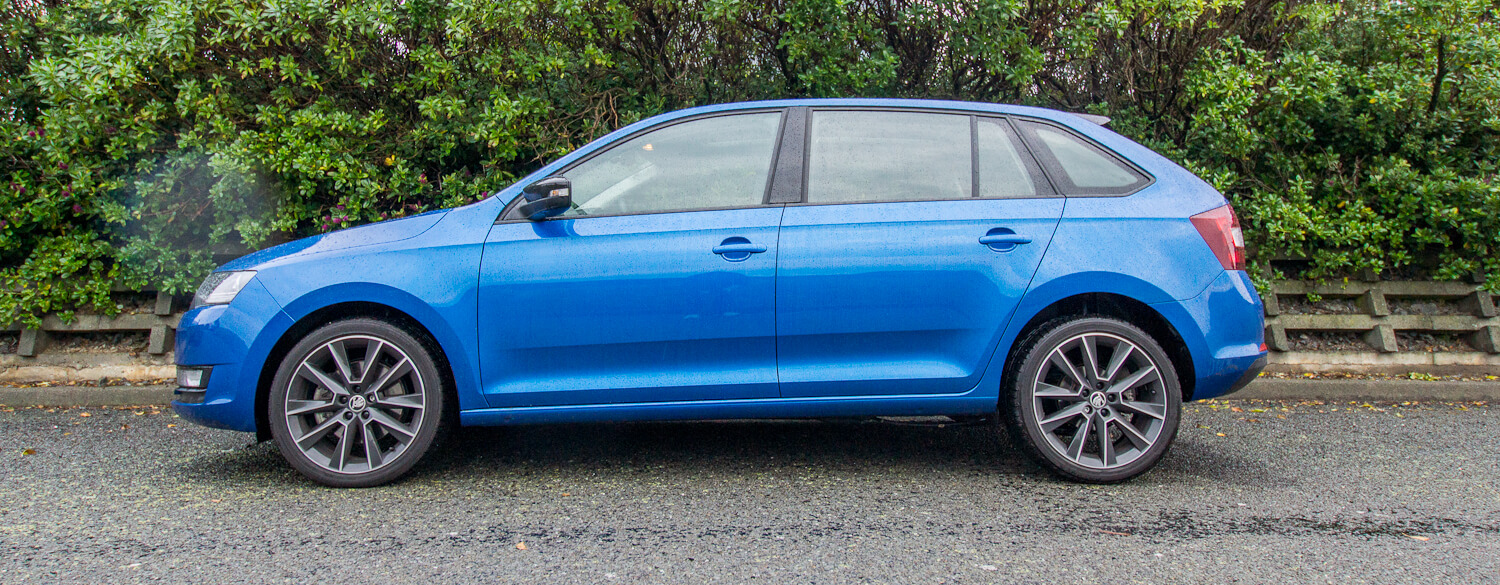
The Rapid has a wide variety of colours to choose from. There are 3 whites, 2 greys, 2 browns, 2 reds, 3 blues, a green and a black. The Ambition comes standard with 16” wheels whereas the Sport comes with 17” as standard.
Both specs come with driver and passenger front curtain and side airbags, ISOFIX child seat preparation in rear seats, hill hold control, flat tyre Indicator, central door locking with 1 x foldable key and 1 x rigid key & immobiliser, cruise control with speed limiter, “Climatic” air conditioning and rear parking sensors as standard features.
The Ambition and Sport also come with Infotainment touchscreen with Bluetooth phone connectivity, reversing camera, Android Auto and Apple Carplay.
For seating, both have cloth seats but in varied styles and patterns, however, the Sport does come with sports seats.
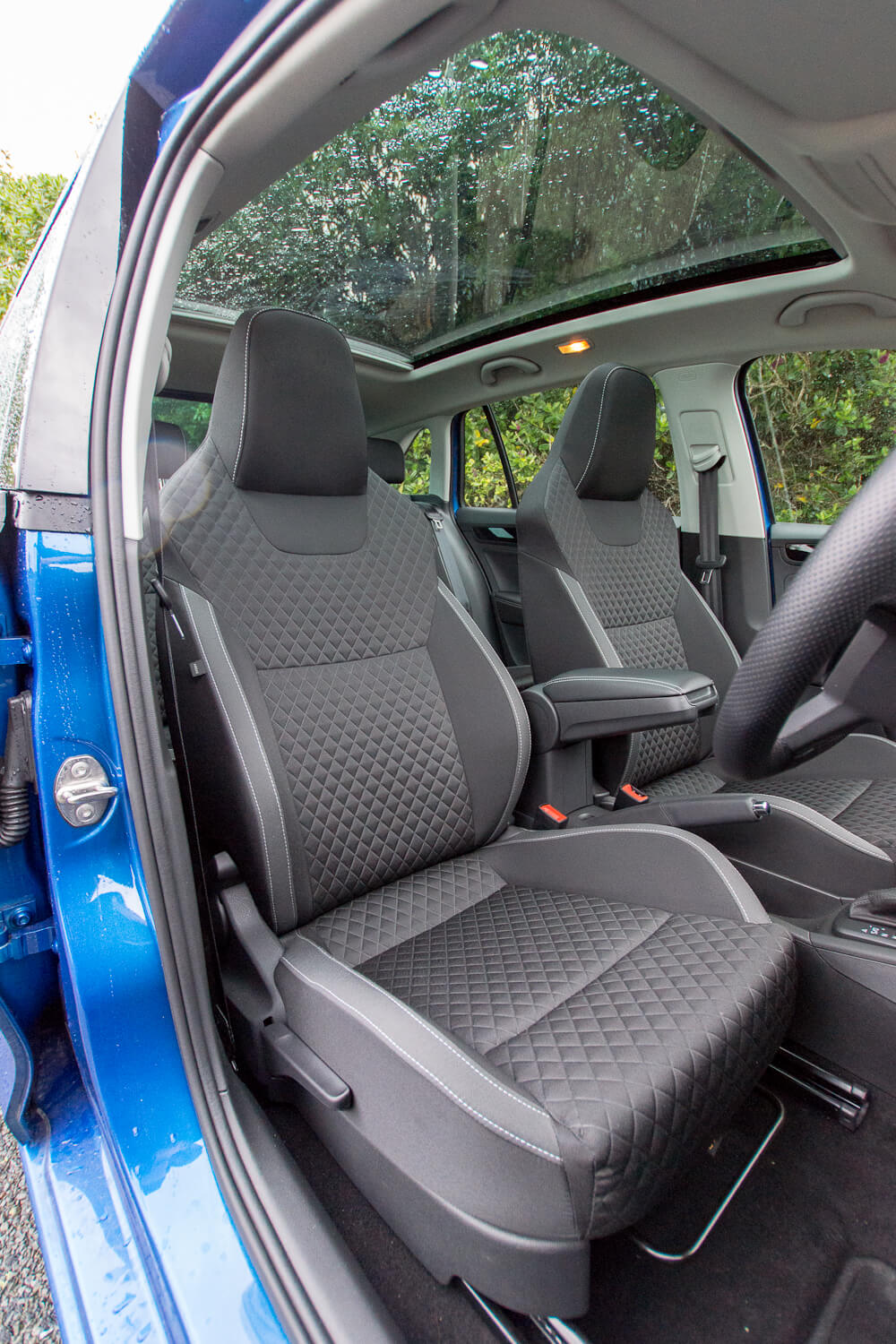
The Sport also comes with some extras over the Ambition, like a fixed panoramic sunroof, 17” black alloy wheels, gloss black door mirrors, darkened rear window with glass extended into tailgate, prolonged rear roof spoiler, black piano decorative inserts, aluminum design pedals, dynamic seat trim and sports comfort seats for the front.
Skoda also offers a range of optional extras like “Climatronic” air conditioning for $1500, Keyless entry with engine start/stop button for $800 and front and rear parking sensors for $850. For the full list of options and prices, you can find them from Skoda here.
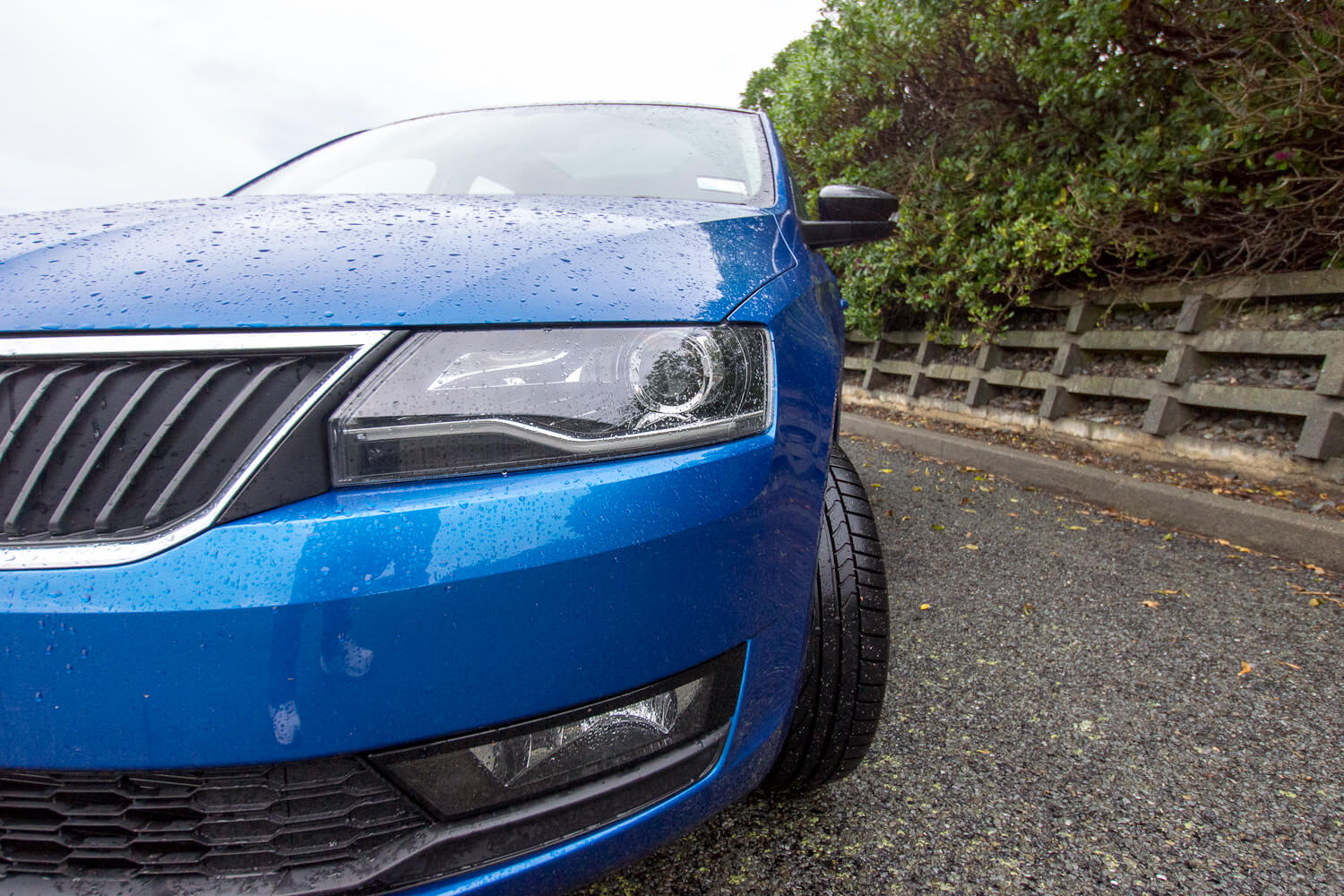
First Impressions
When I saw the Skoda Rapid sitting in the lot in its Race Blue Metallic colour, I thought it was a great looking car. At first, I did not realise that I was getting the “Sport” variant of the Rapid and when I found out I was a bit disappointed with the look. For a car with sport in its name it was a bit bland looking, nothing stood out to me as sport except perhaps the wheels.
I do like the black roof which shares its style from other European cars and the fact that they extended it down the back of the car tied it all in nicely.
On looking inside, I saw the sports seats and again thought maybe there is something to this car.
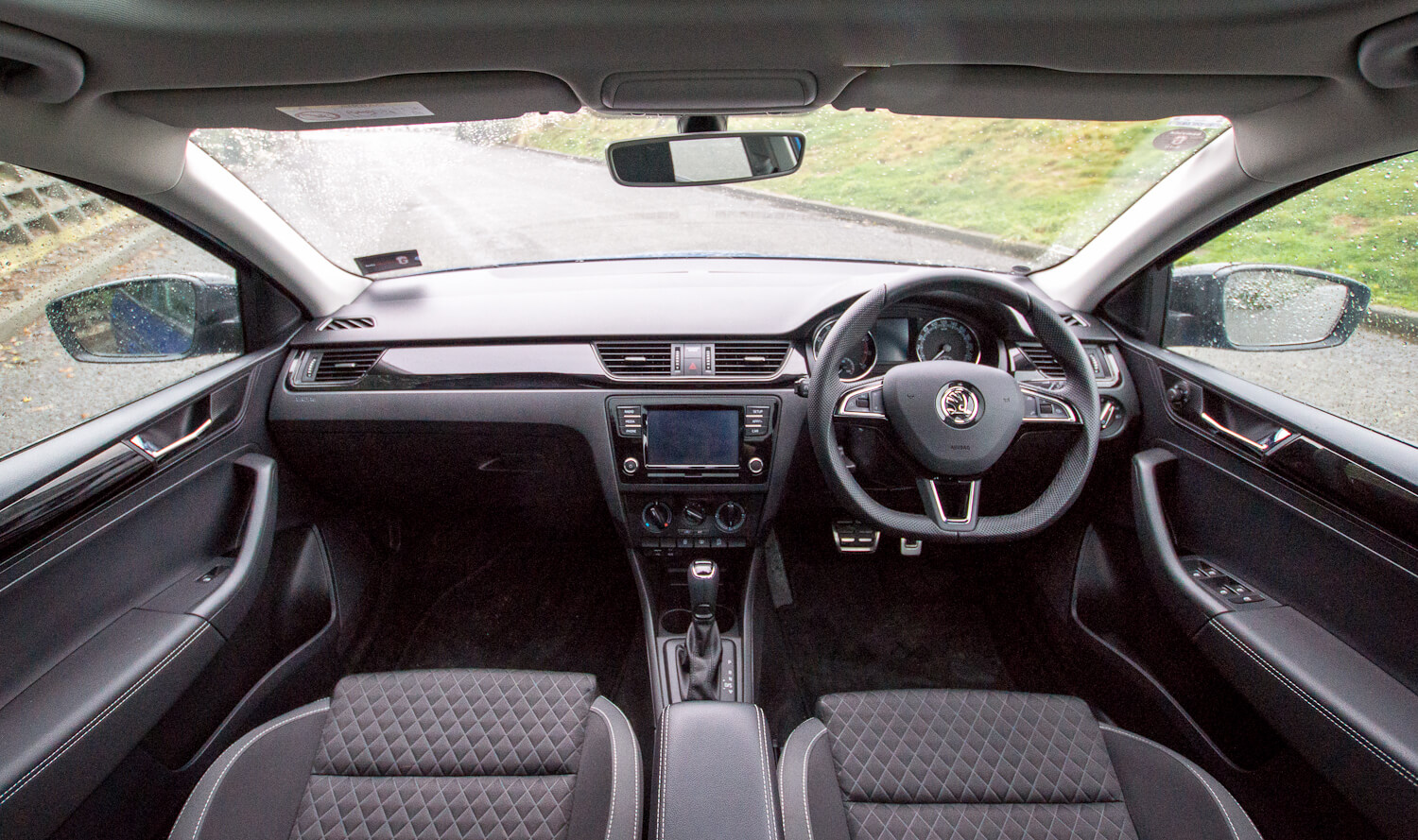
The Inside
Opening the door to get in I was greeted with the sports seats again, but what I had not noticed before was the diamond quilt pattern that had been stitched onto the cloth seats. This did add a touch of luxury as quilted seats are usually something you see in more high-end cars, I will admit they are usually leather but it’s still nice to see.
Sitting down into the sports seats they are also fairly comfy and provide a little bit of support on the sides, but they are not what you might consider full sport bucket seats. These seats also come with a fixed headrest which was fine for me being 6’4” but I wondered if a shorter driver might not find the headrest that comfortable.
Looking around the rest of the cabin I see piano black trim, a black leather armrest, black seats and carpets but realise that even with all the dark surfaces the cabin still feels light and airy. The out of the corner of my eye I notice light coming from above me, I look up to see that basically that entire roof had been replaced with a panoramic sunroof. This makes a huge impact by allowing so much light in, it even goes back over the rear passengers.
In looking back, I notice that what usually would be the C pillar between the back side doors and boot had been divided in two and another bit of glass had been put here. This made for great visibility and basically removed the usual blind spot that would be there, it was like being inside Willy Wonka’s glass elevator.
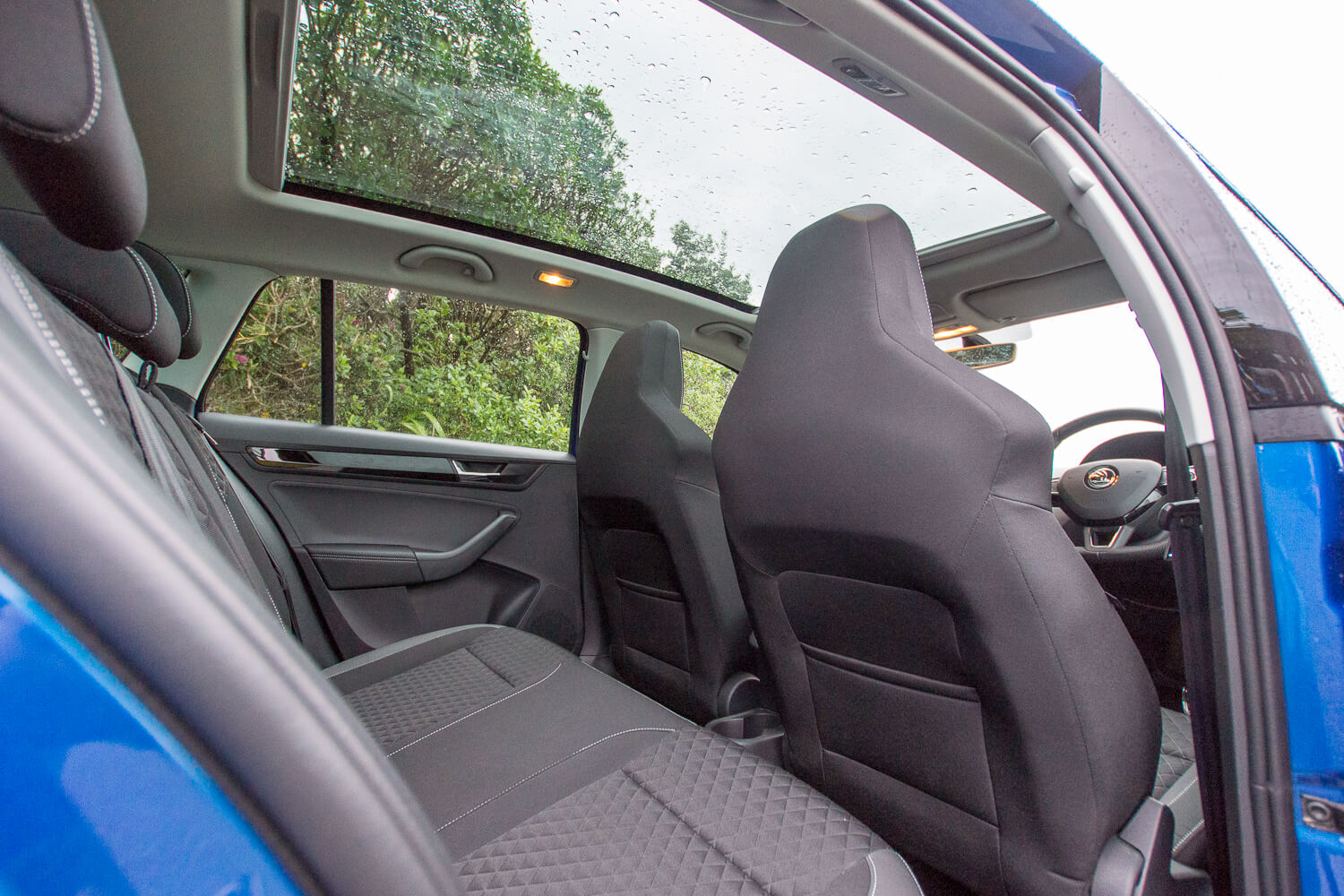
Bringing my attention back to the front you have a fairly simple setup, with the driver’s cluster being the speed and rev counter, with a 3.5” screen in the middle for more driver information.
In the centre console, you have the “Climatic” air conditioning controls. And that is all it is, this is not climate control so you have the fan speed, air flow dial and temp control. I feel this style of setup should have been phased out by now. My car which was made in 2005 does not even have these controls, they are too fiddly to use, do I want more blue or more red and in the middle is not just right. For me, it felt like I was forever adjusting it to get it to a temp that I liked, whereas a system that shows a temperature that I could just set and forget would have been welcome.
Moving on to the infotainment system, this is provided by the “Swing” 6” touchscreen that also supports Android Auto and Apple Carplay. This was an intuitive and easy system to get used to, connecting my phone was a breeze by Bluetooth and finding radio stations was just as simple.
Later in my week of driving the Skoda, I was sat waiting in the car for my partner to come out from an errand so I decided to delve into the menus a bit. I found under the car information screen a separate screen for showing how green I was driving that had a leaf that would dim or brighten depending on how economical my driving was. Being honest I probably did not have this displaying too often. I went back to maps in Android Auto most of the time.
I also stumbled my way into some sound settings and found a setting called Skoda Surround but it was greyed out. I wondered if plugging in my phone and playing music via the USB cable would allow me to turn this on. Low and behold, it did not only that but it also opened up an option for a virtual subwoofer. Virtual or not this brought the music to life – previously I had noted that the audio was a bit flat and boring to listen to but this seemed like it added 5 or 6 more speakers to the car, and there was now considerable bass. I was impressed but also saddened that it turned off again when you went back to the radio.
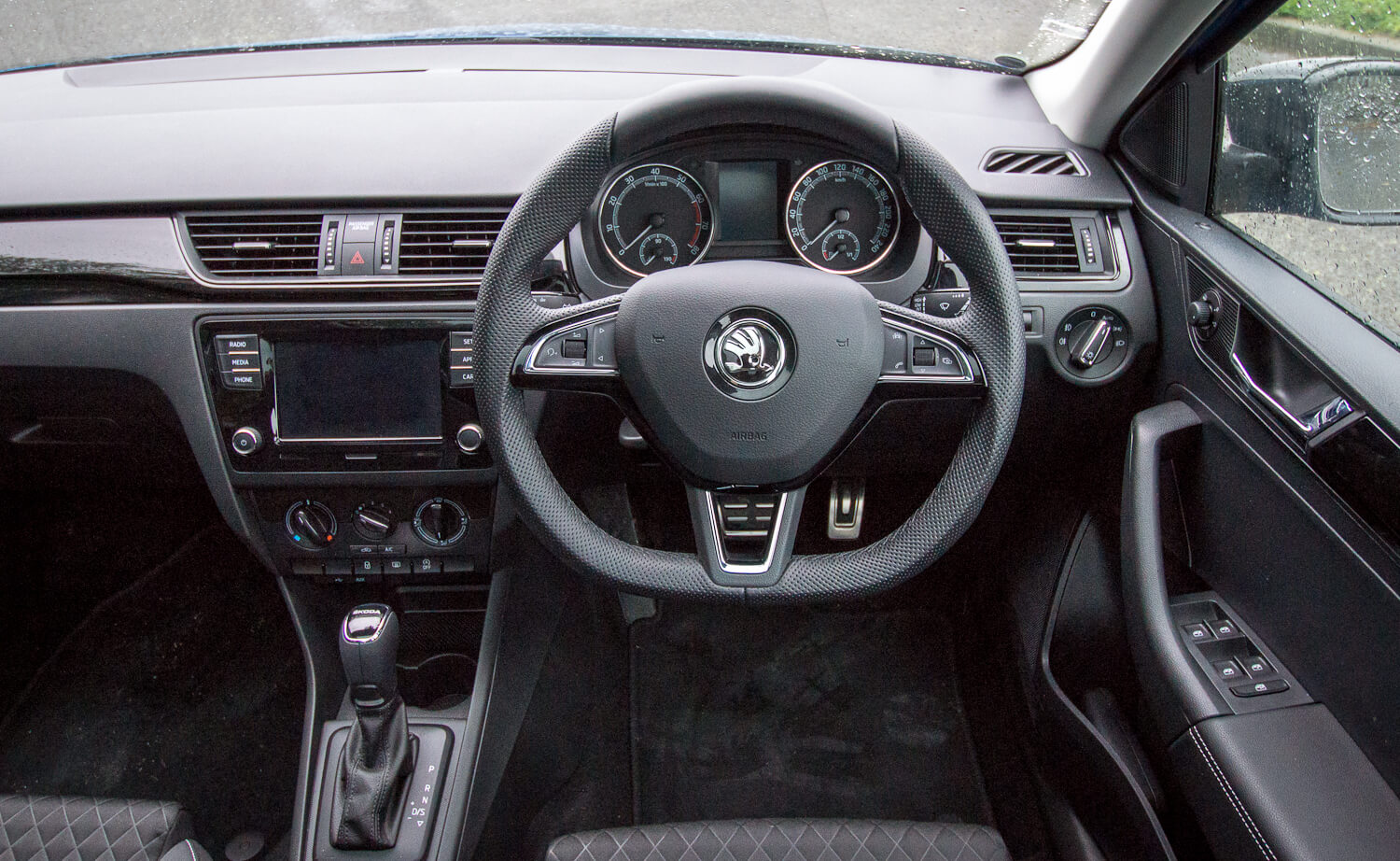
The Drive
Let’s talk about the drive shall we, and let’s start almost at the very beginning: the handbrake. The handbrake itself I don’t have a problem with, it does what it is supposed to but releasing it turned out to be fairly difficult. This was due to the fact that I could not get a good grip on it because the armrest was covering almost 80% of the handle. You might think “yea”/”whatever” just lift the armrest and then do it. But not only does the armrest have several height settings so you would have to find your one again but also when it is full up right it does not line up with seat, so it ended up digging into my ribs. Another thing that the armrest also made difficult to do if you’re of a larger figure is putting your seatbelt on, it just seemed to be always in the way. I am surprised no design or usability testing picked this up.
I will move on to the actual driving, the engine being a 1.4-litre turbo producing 92kW and 200Nm of torque. It was surprisingly peppy, giving you decent acceleration and enough grunt that when loaded down with 4 adults inside you did not feel like you had to will it up the next big incline. The 7-speed DSG that the VASK group of cars are known for is as strong as ever, giving buttery-smooth gear transitions.
Driving the Rapid around town was a doddle, it’s small enough to fit in even some of the smallest car parks with ease yet big enough to carry all that you would need. The boot in the Rapid is 415 litres which is one of the largest you will find in its class, if not the largest. And if that was not enough you could lower down the rear seats to give you 1,381 litres of room, which is massive for the small family hatchback market.
Another thing that was great in the boot, was a full-size spare tyre. Not an alloy wheel but a full-size tyre is rare to find.
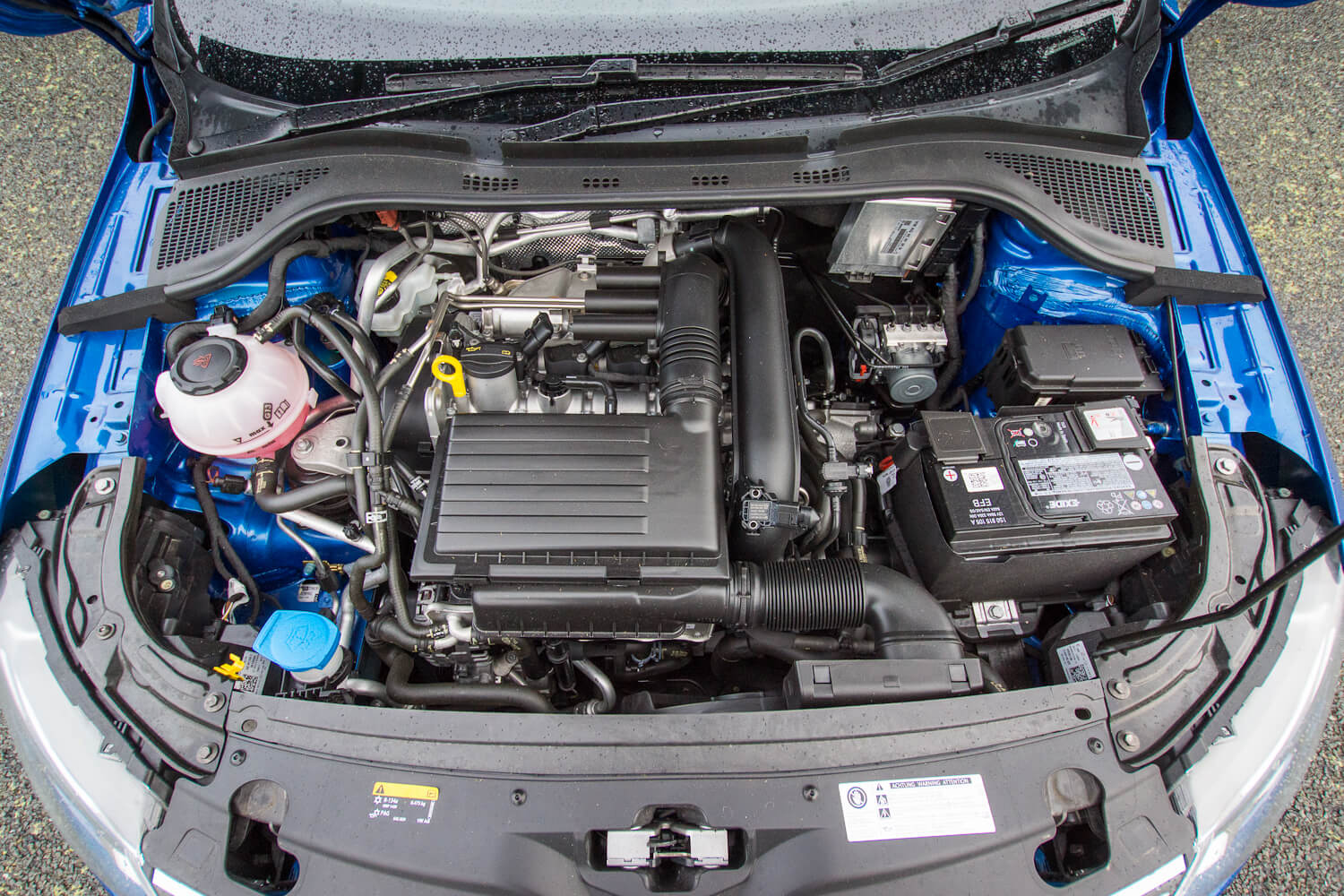
One problem that I did come across, however, was the rear view mirror. It was fairly narrow which worked great if you just wanted to see out the rear window as it almost matched up. But if you had kids and the back you want to keep an eye on it was rather difficult. You would have needed to adjust to be covering both areas at a time, which is not great
I did manage to take the Rapid over the Remutaka Hill to visits my parents and it turned out to be great on the motorway as well as the twisty roads. The suspension was soft enough to take the bumps of the motorway but stable when put into the corners – it did corner fairly flat with little body roll to be felt.
I noticed while on the motorway a button on the steering wheel. From previous cars, I would have recognised the symbol as some kind of radar system. Not knowing what system this Skoda offered from off the top of my head I pushed it to see what it did. Nothing. Well not exactly nothing, it put a message on the driver display saying that the function was not usable. Huh? Why give me a button that I can’t use. I did not get it. If the car does not have the function remove the button.
Looking up the manual later it turned out to be the front radar assist that monitors the car in front of you and warns you if it detects an impending accident.
On the drive back I figured it was time to figure out how economical this car was. Having driven to and from work for half the week and a few trips into town I had only used ⅛ of the 55L petrol tank according to the dial before heading out on our small road trip. By the time I had returned to town it had only just gotten past the halfway mark on the petrol gauge. It was sipping at the fuel, by the end of the week my fuel consumption according to the on-board computer was 6.4L/100km. Considering I drove the car no different to my own it was really getting good use out of the petrol.
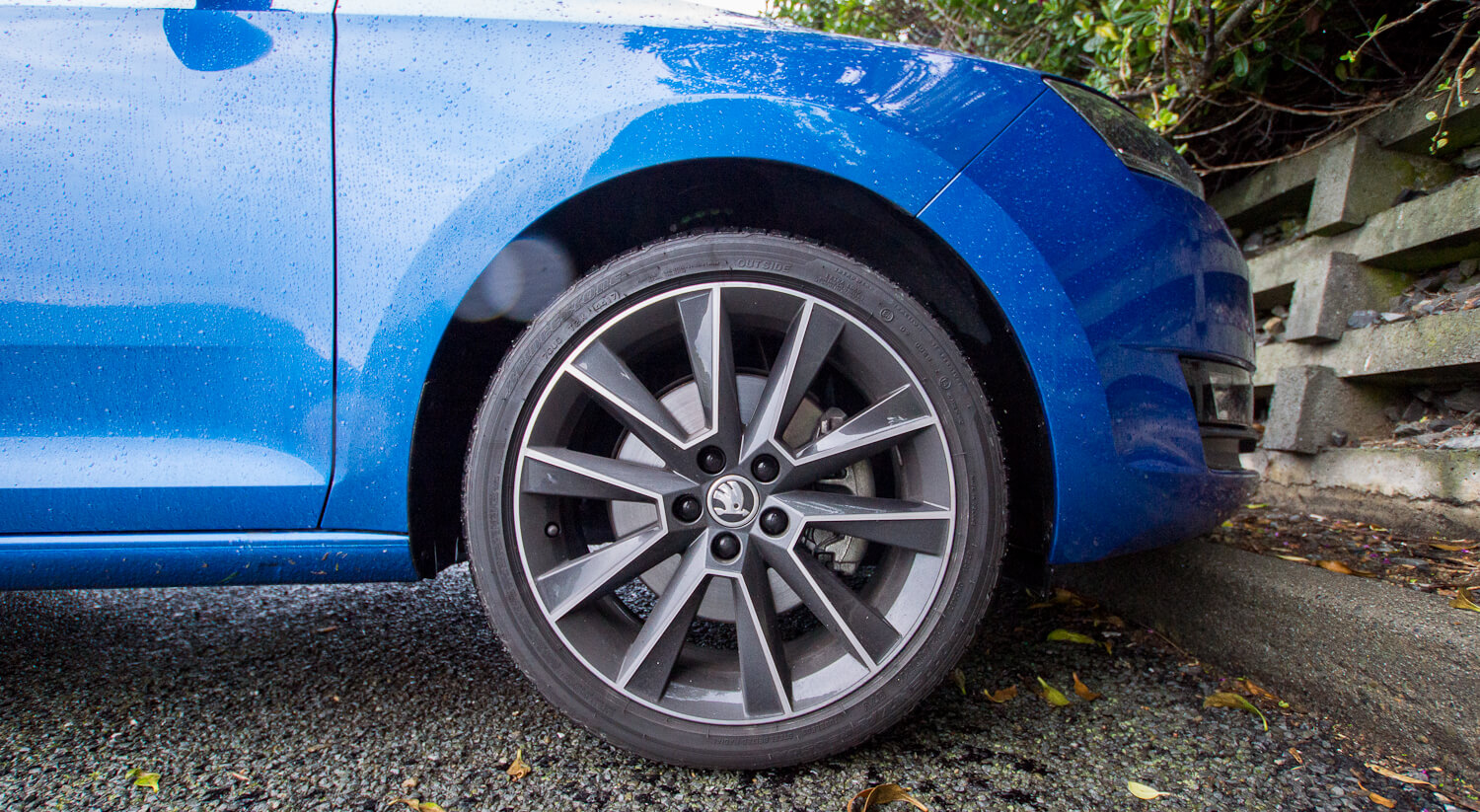
The Competition
| Brand/Model | Engine | Power/Torque | Fuel, L/100km | Boot Space, Litres | Price Highest to Lowest |
| Audi A3 Sportback | 1.4L Turbo Petrol | 110kW/250Nm | 4.9L/100km | 380 Litres | $50,900 |
| Mercedes A180 | 1.6L Turbo Petrol | 90kW/200Nm | 5.8L/100km | 340 Litres | $49,800 |
| VW Golf TSI Comfortline DSG | 1.4L Turbo Petrol | 92kW/200Nm | 5.5 L/100km | 380 Litres | $37,490 |
| Seat Leon | 1.4 Turbo Petrol | 110kW/250Nm | 4.9L/100km | 380 Litres | $35,900 |
| Hyundai 1.6 Hatch | 1.6L Petrol | 94kW/156Nm | 6.8L/100km | 395 Litres | $35,990 |
| Ford Focus Trend | 1.5L EcoBoost Petrol | 132kW/240Nm | 6.7L/100km | 316 Litres | $35,340 |
| Toyota Corolla Hatch Levin SX | 1.8L Petrol | 103kW/173Nm | 6.1L/100km | 360 Litres | $33,990 |
| Honda Civic SX Hatch | 1.8L Petrol | 104kW/174Nm | 6.4L/100km | 400 Litres | $32,990 |
| Mazda 3 GLX | 2.0L Petrol | 114kW/200Nm | 5.8L/100km | 308 Litres | $32,795 |
| Holden Astra Hatch R | 1.4L Turbo Petrol | 110kW/240Nm | 5.8L/100km | 360 Litres | $30,990 |
| Skoda Rapid Sport Spaceback | 1.4L Turbo Petrol | 92kW/200Nm | 5.5 L/100km | 415 Litres | $29,990 |
| Suzuki Baleno GLX | 1.4 VVT Petrol | 103kW/220Nm | 5.4L/100km | 355 Litres | $23,990 |
The pros and cons
| Pros | Cons |
|
|
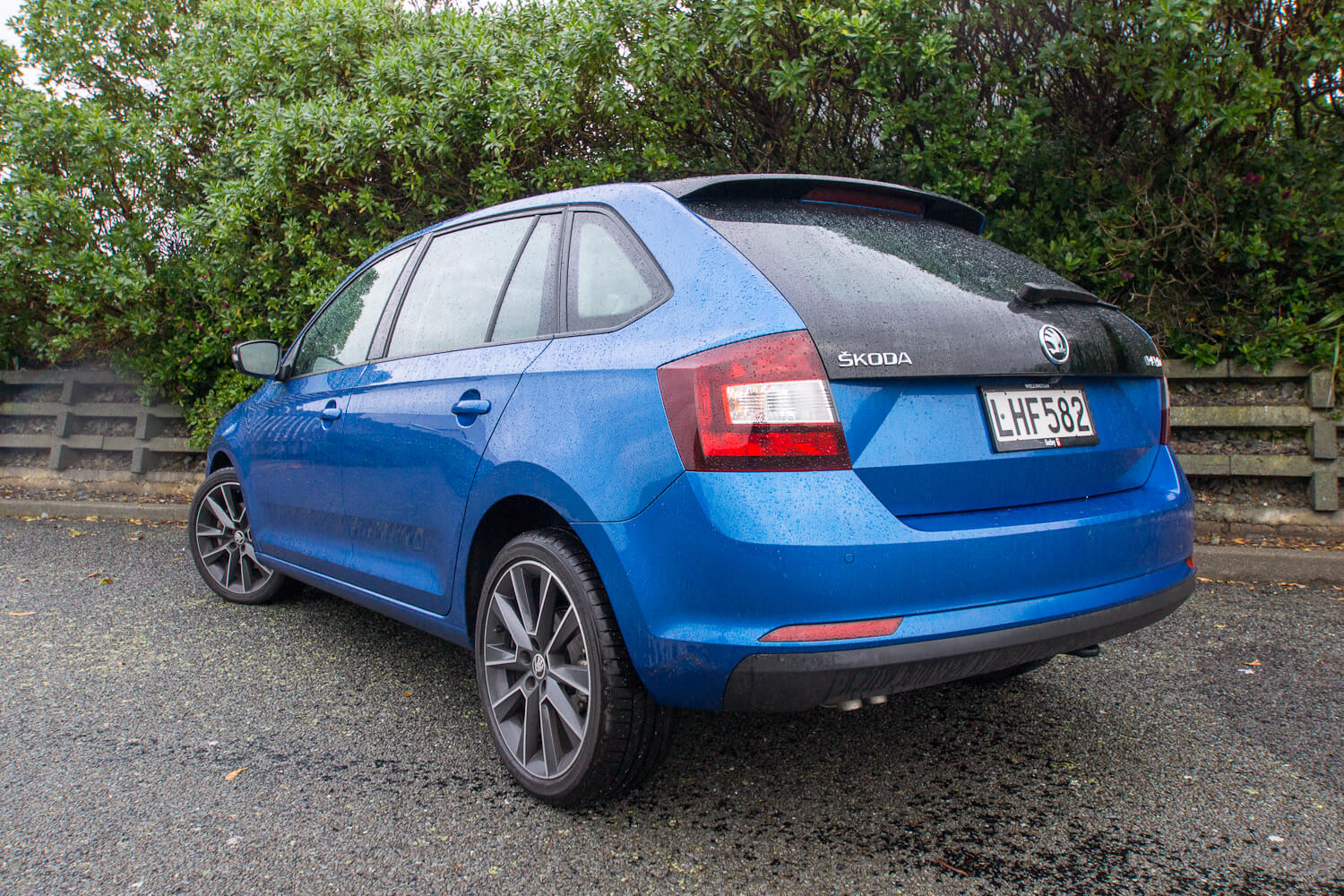
What we think
Overall I did think the Skoda Rapid Sport Spaceback – however a mouthful – was a good value for money car. You are getting a lot for your money and it will make your fuel go that bit further. I do have some small hangups around some design choices (armrest) that I can’t let go.
But apart from this, it is a great little family hatch – and that is why I give it 4 out of 5 Chevrons.
Rating – Chevron rating (4 out of 5)
2018 Skoda Rapid Sport Spaceback
| Vehicle Type | Hatchback |
| Starting Price | $29,990 plus on-road costs |
| Tested Price | $29,990 plus on-road costs |
| Engine | 1.4-litre 4-cylinder turbocharged petrol |
| Power Kw / Torque Nm | 92kW/200Nm |
| Transmission | 7-speed DSG dual-clutch |
| 0 – 100 kph, seconds | 9.0 |
| Spare Wheel | Full size |
| Kerb Weight, Kg | 1231 |
| Length x Width x Height, mm | 4304 x 1940 x 1459 |
| Cargo Capacity, litres | 485 seats up
1579 seats folded |
| Fuel Tank, litres | 55 |
| Fuel Efficiency | Advertised Spec – Combined – 5.5 L / 100km
Real World Test – Combined – 6.4L / 100km Low Usage: 0-6 / Medium Usage 6-12 / High Usage 12+ |
| Towing | 610kg unbraked
1,200kg braked |
| Warranty | 3 years/100,000km and “Long life” servicing: 2 years or up to 30,000km |
| ANCAP Rating | 5 stars |


